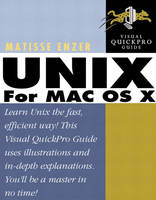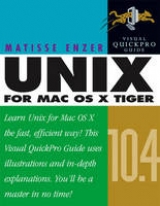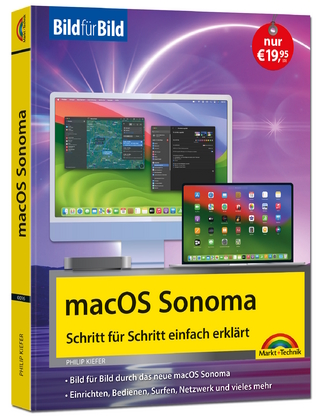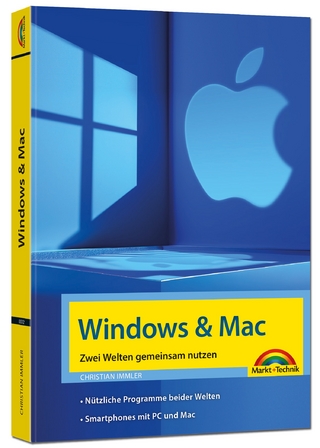
UNIX for Mac OS X
Peachpit Press Publications (Verlag)
978-0-201-79535-6 (ISBN)
- Titel erscheint in neuer Auflage
- Artikel merken
With Mac OS X, Apple has completely rebuilt the Macintosh operating system from the ground up--and yes, it's Unix that's running this new Mac OS. Mac users can now use the terminal command line to write a Perl script, automate batch commands, run an Apache server, use sendmail, and grep to their heart's delight. And alternately, many experienced Unix programmers are thrilled to be able to write shell scripts on the Mac platform. Unix for Mac OS X: Visual QuickPro Guide shows readers how to configure their Unix environment, navigate permissions, directories and files, run handy Unix utilities, configure and run the Apache Web server, and much more. In addition, readers will learn how to protect their files with Unix's security tools, and how to fix their Macs when things go wrong.
Matisse Enzer studied architecture at the Cooper Union in New York City and with renowned architect Christopher Alexander (A Pattern Language) in California. Matisse worked at The WELL during the time it became one of the very first online communities to connect to the Internet. Since 1994 he's worked as a self-employed Internet consultant, designing and building a wide variety of systems. This is his first book for Peachpit Press.
Introduction.
Who Is This Book For? Whats in This Book? How to Use This Book. Requirements.
1. What is Unix, and Why Is It Good?
The Advantages of a Unix-based Mac OS. But First, a Little History. How Mac OS Xs Unix Differs from Mac OS 9. What You Can Do with Mac OS X and Unix. How You Will Be Working with Unix.
2. Using the Command Line.
Getting to the Command Line. Understanding the Shell Prompt. Using a Command. Using Common Commands. About Commands, Processes, and Jobs. About Spaces in the Command Line. Wildcards. About Standard Input and Output. Creating Pipelines of Commands. Running a Command in the Background. Opening Files from the Command Line. Creating a Simple Unix Shell Script.
3. Getting Help and Using the Unix Manual.
Using the Unix Manual. Printing Man Pages. Using Commands Built-in Help. Getting Help from Other People.
4. Useful Unix Utilities.
Mac OS X—Specific Utilities. File Compression and Archiving. File and Text Processing. Searching for Text. Searching for Files. Viewing and Editing Files. Sending Email. Network Analysis. Using the Internet.
5. Using Files and Directories.
Seeing the Whole File System. Seeing Where You Are in the File System. Understanding and Using Unix Filenames. Moving Around in the File System. Seeing the Contents of Directories. Viewing the Contents of Text Files. Creating Files and Directories. Copying Files and Directories. Renaming or Moving Files. Deleting Files and Directories. Getting Information about Files and Directories. About Links (the Unix Version of Aliases).
6. Editing and Printing Files.
Editing Files with vi. About vis Two Modes. Navigating Using vi. Saving a File in vi. Quitting vi. Changing and Deleting Text. Emacs—an Editor Without Modes. Printing Files.
7. Configuring Your Unix Environment.
Finding Configuration Files. Configuring Your Shell. Environment Variables. Shell Aliases. Shell Settings. Configuring vi.
8. Working with Permissions and Ownership.
About Users and Groups. The Root User—Permission to Do Anything. Understanding Permissions and Ownership. Setting and Changing Permissions. Changing Ownership. Default Permissions for File Creation. Recognizing Permission Problems.
9. Creating and Using Scripts.
Creating a Shell Script. Using Variables. Using Arguments. Using Commands within Commands. Doing Arithmetic and Using Expressions. Using Control Structures. Getting User Input. Creating and Using Functions.
10. Connecting Over the Internet.
About Hostnames. Logging in to Another Unix Machine. Copying Files Between Unix Machines. More Advanced Interactions.
11. Introduction to Systems Administration.
About root. Becoming Another User. Backups. Managing User Accounts and Groups. Monitoring System Usage. Running Regularly Scheduled Commands. System Log Files. The Boot Sequence. Setting the Hostname. Creating a New StartupItem. Webmin—A GUI Tool for System Administration. Troubleshooting Tips.
12. Security.
Physical Security. Choosing Good Passwords. Protecting Yourself from Internet Attacks. Searching for Files that Make You root. Keeping Up-to-Date. Monitoring Files for Changes. Security Checklist.
13. Installing Software from Source Code.
Installing from Source Code—the Basics. Using Fink to Install Software. Manually Installing from Source Code. Installing Perl Modules.
14. Installing and Configuring Servers.
Setting Your Machines Hostname. Controlling the AppleShare Server. Activating the SSH Server. Configuring Sendmail—Internet Email Server. Activating the FTP Server. Apache: A Web Server. Even More Servers.
Appendix A. For More Information.
About Darwin. About Open-Source and Free Software. General Help Resources. Languages and Programming. Mac OS X in General. People. Protocols and Standards. Security. System Administration. Unix in General. Unix/Darwin Software. Miscellaneous.
Appendix B. Glossary.
Index.
| Erscheint lt. Verlag | 12.12.2002 |
|---|---|
| Verlagsort | Berkeley |
| Sprache | englisch |
| Maße | 178 x 228 mm |
| Gewicht | 851 g |
| Themenwelt | Informatik ► Betriebssysteme / Server ► Macintosh / Mac OS X |
| Informatik ► Betriebssysteme / Server ► Unix / Linux | |
| ISBN-10 | 0-201-79535-3 / 0201795353 |
| ISBN-13 | 978-0-201-79535-6 / 9780201795356 |
| Zustand | Neuware |
| Informationen gemäß Produktsicherheitsverordnung (GPSR) | |
| Haben Sie eine Frage zum Produkt? |
aus dem Bereich



